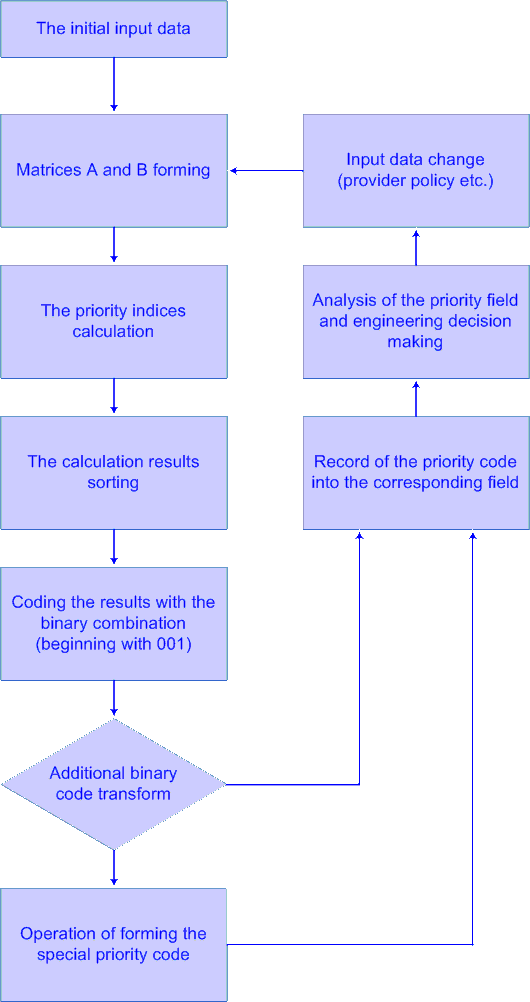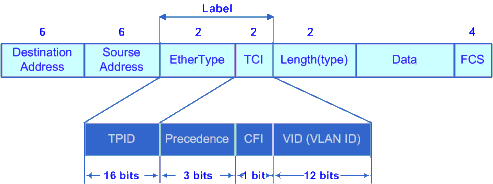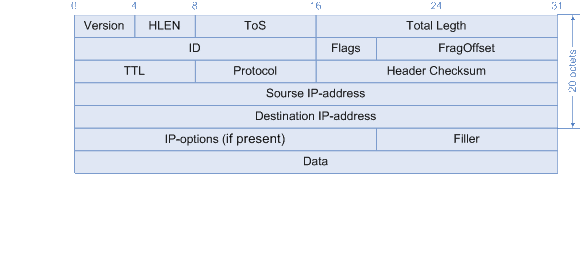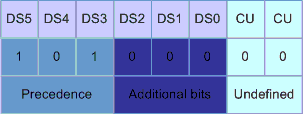| Autobiography |
| Abstract |
 |
| Master'09 |
| DonNTU | Українська | Русский | English |
|
|
Fazulyanov SergeyFaculty: Computer
Information Technologies and Automation (CITA)
|
The name of
master's work:
|
ABSTRACT
|
||||||||||||||||||||||||||||||||||||||||||||||||||||||||||||||||||||||||||||||||||||
 , , |
(1-4) |
where Ai1 is the relative packet loss rate, Ai2 – the relative delay rate, Ai3 – the relative jitter rate, Ai4 - the relative bandwidth rate. The relative generalizing coefficients are calculated for bringing the existing data to a common form that is amenable to further mathematical processing.
Matrix B is filled with numbers 1, 2 and 3, which represent respectively low, medium and high importance of QoS requirements. These parameters can be taken in accordance with the classical requirements or may be determined by the provider. The coefficients Bij are used for account of the importance of each traffic class QoS requirement when calculating the priority. The value of priority for traffic classes are calculated using the formula (5):
 |
(5) |
This formula can be adapted for any number of the
traffic classes and different QoS requirements. The result of
calculation is a decimal number 0
The results of calculations are displayed in the last column of table 1. In the quotation marks the number of the data packet processing priority is indicated.
Table 1 - QoS Requirements for Different Traffic Classes and Their Relative Priority
|
Traffic classes |
і |
Показатели QoS |
Приоритет Pri |
|||
|
Losse P, % |
Delay T, ms |
Jitter dt, ms |
Bandwidth C, kbps |
|||
|
j=1 |
j=2 |
j=3 |
j=4 |
|||
|
Voice |
1 |
< 0,25 |
150 |
< 10 |
21-106 |
0,2430 (2) |
|
IPTV |
2 |
< 2 |
1000 |
< 30 |
10240 |
0,1527 (4) |
|
Video Conferences |
3 |
< 1 |
150 |
< 30 |
12288 |
0,2314 (3) |
|
Interactive Data |
4 |
< 0,1 |
400 |
No importance |
128 |
0,0950 (5) |
|
Audio |
5 |
< 1 |
1000 |
<15 |
256 |
0,0157 (6) |
|
Signaling Traffic |
6 |
< 0,1 |
100 |
No importance |
64 |
0,2514 (1) |
|
Best Effort |
7 |
< 2 |
1000 |
No importance |
64 |
0,0109 (7) |
This criterion allows creating a unified and formalized approach to the service prioritization of any multiservice networks traffic class, which are necessary for solving the problems of effective network resources engineering.
The methodology offers to label packets with a code combination received from the previous calculation of the criteria values for each traffic class[6]. For this purpose at the initial stage of the operation systems are determined together with the input data, which are formed by both the QoS requirements and the provider’s policy. The next step after getting the criterion values for each traffic class is allocating the code combination to each class, which corresponds to the criteria value for this traffic class. Then the received combinations are recorded in the corresponding fields of the network protocols that have been marked above.
Методика может быть использована для разграничения очередности обработки классов траффика мультисервисных сетей с использованием разных сетевых протоколов, которые приспособлены для указания уровня приоритета в заглавиях пакетов.
The method can be used to distinguish the processing order for traffic classes of the multiservice networks using different network protocols adapted for specifying the priority level in the packets titles. The process of determining priority may be automated by creating software that would perform the calculation of the relative priority after determining the new values of input variables.
The methodology algorithm is shown in the figure.

Figure 1. The Methodology Algorithm
One of the characteristics of the methodology implementation is the different code priority presentation form in different specialized fields of the subheadings of packages of different network protocols.
The standard 802.1p considers the principles of the priority traffic organization at L2 level, based on the use of fields of 802.1Q standard[7]. 802.1p standard is a part of the 802.1D standard (bridge connection). The 802.1Q protocol defines 4 bytes of the label which transmits information about the origin of the package to one or another VLAN. It consists of two parts - EtherType field and group of fields forming TCI (Tagged Control Information). EtherType field is used in the label as TPID (Tagged Protocol Identifier) that contains information about the necessity of processing a frame according to IEEE 802.1Q.

Figure 2. VLAN Tags Format at L2 Level (802.1p Standard)
A part of a tag which consists of the traffic class priority fields (CoS, Class of Service), CFI (Canonical Format Identifier) and 12-bit field VID (VLAN ID) is called TCI (Tagged Control Information). CoS priority codes are labelled by user. After adding the label into the frame it is required to recalculate the FCS checksum. In such a case, this link layer must support multiple queues. While adding a tag the maximal possible frame length (1518 bytes) may be exceeded. In this connection, IEEE is developing a 802.3aс specification, in which the maximal length of the frame is increased up to 4 octets[8].
The calculated 3-bit combination that encodes the relative class traffic priority is placed in the priority field without problems, and no additional operations for coding words transforming are required.
Traffic Engineering at L3 level in the TCP / IP protocol stack is based on the capacity of these transport protocols (IP, UDP, TCP). IP protocol provides ToS values setting, determined by the corresponding header field[9].
The type of service field (TOS - type of service) describes how the datagram should be handled. TOS field format is defined in the RFC-1349 document. This field is divided into 6 subfields. C, D, T and R bits describe the request for ways of the datagrams deliver. D = 1 requires minimal delay, T = 1 - high bandwidth, R = 1 - high reliability, and C = 1 - low cost. Simultaneously, a combination of these four fields can contain only one bit equal to 1. The default value of all four bits is zero.

Figbre 3. Type of
Service Field Format
(Animation: frames - 10, cycles - 7, duration - 42 sec)
3-bit priority subfield (IPP - IP Precedence) provides the ability to assign a code priority to each datagram. To place a combination determining the relative traffic class priority value in the field of IP Precedence no additional transforms of the calculated codeare required. To set D, T, R, C bit values it is necessary to introduce into the algorithm of the method additional operands which will generate code for the traffic type with the maximal sensitivity of a particular traffic class to one or another QoS indicator. Currently the ToS field is not used.
In the RFC-2474 recommendations TOS field has been replaced by DSCP field (Differentiated Services Code Point), where 6 lower bits define the DS code (Differentiated Services), and 2 higher bits are not defined and are subject to nullification[10].
Since the beginning of intensive development to ensure the QoS indicators there increased an attention to the possibility of using ToS field, which was ignored in most implementations before. In 1998, inRFC-2474 there appeared the proposal to replace the ToS field to DSCP field, which also has a length of 8 bits, but, unlike the ToS field, only 6 bits are involved in the services code definition. The remaining 2 bits are currently not defined. Sometimes DSCP field is called DS byte (Differenttiated Services).

Figure 4. DSCP Field Format
. DSCP Field Format. DS0-DS5 bits define a class selector. The value of this code are presented in the table below. Standard default DSCP value is 000000.
Table 2. Class Selector DSCP
|
Class Selector |
DSCP |
|
Priority 1 |
001000 |
|
Priority 2 |
010000 |
|
Priority 3 |
011000 |
|
Priority 4 |
100000 |
|
Priority 5 |
101000 |
|
Priority 6 |
110000 |
|
Priority 7 |
111000 |
In addition, PHB (per Hop Behavior) is DSCP-based. The policy defines DSCP codes within classes, that significantly expands the ability for network resources engineering and the required QoS level ensuring.
To adapt the methodology for use with the DSCP field it is required to introduce into the algorithm the operands which will add into the code combination determining the traffic class priority a combination of three bits to convert the results into the DSCP field format. These bits can be formed based on PHB, by introducing into the method coresponding operands, or taken equal to 0 for 6-bite class selector combination getting.

Figure 5. Adding Extra Bits to the Traffic Class Priority Code to Put It into DSCP Field
According to the RFC-1883 document the priority field in IPv6 protocol had 4 bits[11]. For this purpose priority value fields are divided into two sub-bands. Codes from 0 to 7 are used to set the traffic priority for which the overload control is performed, codes from 8 to 15 are used to determine the traffic priority for which the overload tracking and processing is not made, for example, in the case of the real time traffic.
Currently, according to the RFC-2460, the priority field is replaced by a traffic class field of 8 bits length[12]. In such a way the size of the flow label field was reduced to 20 bits. Thus the IPv6 packet header format was given to "Definition of the Differentiated Services Field (DS Field) in the IPv4 and IPv6 Headers" RFC-2474 requirements, oriented on QoS traffic engineering.
Simulation of Multiservice Telecommunication Networks Using the Developed Method of Prioritization is planned to perform in Opnet. This software allows creating a diverse data stream that will simulate the part of the multiservice network with the need of the resources distribution management between different classes of services. Simulation will consist of several experiments:
- Simulation of functioning of the part of multiservice
network without the usage of prioritization
- Simulation of functioning of the part of multiservice network with
prioritization based on one of the conditions (bandwidth, delay, etc.)
- Simulation of functioning of the part of multiservice network using
the developed method to prioritize
On the basis of the results the conclusion on the effectiveness and quality of decision will be made.
In the future we plan to make an investigation of the possibility to adapt the methodology of the relative priority values calculation for use in the traffic compressors, the definition of specifics of the method implementation in traffic engineering systems, in the networks built by different network technologies.
Also one of the areas of research may be elected a study of the possibility of adding into the methodology a more explicit definition of the packages sensitive to a specific QoS request. Within this study it is planned to investigate the possibility of forming DSCP codes with regard to per Hop Behavior policy for the finer distribution of network resources.
During carrying out the work there were examined guidelines for the multiservice telecommunications networks traffic prioritization, a review of the basic principles of the priority traffic organization in the modern telecommunication networks was made. The reasoning of the work purpose was considered as the creation of formalized methodology for prioritization services of the multiservice telecommunication networks based on the criterion of the relative traffic classes priority calculation according to the requirements put to the Quality of Service forward by the traffic classes and providers.
We propose the formalized criterion for determining the relative traffic classes priority of the multiservice networks, based on the QoS requirements, put forward by the traffic classes and the telecommunication providers. A basic algorithm of the methodology operation, based on the proposed criterion, is worked out.
The features of the priority traffic organization, described by various standards and recommendations, are studied. The directions for further research aimed at adapting the developed methodology for practical application in terms of the real multiservice telecommunication networks are defined.
1. Крылов
В.В. Теория
телетрафика и ее
приложения./ В.В. Крылов, С.С. Самохвалова. – СПб.:
БХВ-Петербург. –2005.
– 288 c
2. Vegesna S. IP Quality of Service./ Srinivas Vegesna.
– Cisco Press.
– 2001. – 368 p
3. Фазульянов С.В. Критерій визначення відносного пріоритету класів
трафіку мультисервісних мереж. - Сучасні проблеми радіотехніки та
телекомунікацій «РТ - 2010»: Матеріали 6-ої міжнар.
молодіжної наук.-техн. конф., 19 – 24 квітня 2010 р.
—
Севастополь: Вид-во СевНТУ, 2010. – стор. 162.
4. Норенков И.П. Основы автоматизированного проектирования: Учеб. для
вузов./ И.П.Норенков – М.: Изд-во МГТУ им. Н.Э. Баумана,
2000.
–360 с.
5. ITU-T Recommendation Y.1540/Y.1541. Network perfomance objectives
for IP-based services. Geneva: International Telecommunication
Union.[Electronic resourse]
– 2006./ -Acces mode to article: http://www.itu.int/rec/dologin~type=items
6. Дегтяренко І.В., Фазульянов С.В. Методика визначення відносного
пріоритету класів трафіку мультисервісних мереж. –
Науково-технічна конференція «Проблеми
телекомунікацій»: Збірник тез. К.: НТУУ
«КПІ», 2010. – стор. 188
7. Олифер Н., Олифер В. Базовые технологии локальных сетей./Н.Олифер,
В.Олифер –
Центр Информационных Технологий, 1999
8. Семенов Ю.А. Telecommunication technologies - телекоммуникационные
технологии (v3.3, 10 мая 2010 года) [Electronic
resourse]/Ю.А. Семенов./ - Acces mode to
article: http://book.itep.ru
9. Type of Service in the Internet Protocol Suite; RFC-1349,
July 1992 [Electronic resourse]/P.
Almquist./ - Acces mode to article: http://www.ietf.org/rfc/rfc1349.txt
10. Definition of the Differentiated Services Field (DS Field)in the
IPv4 and IPv6 Headers; RFC-2474, December 1998 [Electronic resourse]/K.
Nichols./ - Acces mode to article: http://www.ietf.org/rfc/rfc2474.txt
11. Internet Protocol, Version 6 (IPv6); RFC-1883, December
1995 [Electronic resourse]/S. Deering, R.
Hinden./ - Acces mode to article:
http://www.ietf.org/rfc/rfc1883.txt
12. Internet Protocol, Version 6 (IPv6); RFC-2460, December 1998
[Electronic resourse]/S. Deering, R.
Hinden./ - Acces mode to article: http://www.ietf.org/rfc/rfc2460.txt
| Note
When writing this abstract the master’s qualification work is not completed. Date of the final completion of the work is December 1, 2010. The full text of the work and materials on the work theme can be received from the author or his scientific supervisor after that date. |